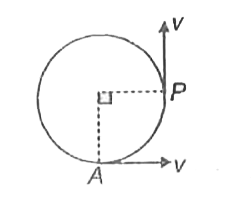A particle of mass 1 kg is moving in SHM with path length 0.01 m and a frequency of 50 Hz. The maximum force in newton, acting on the particle is
150π2
200π2
100π2
50π2
The correct Answer is:C
To solve the problem step by step, we will calculate the maximum force acting on a particle moving in Simple Harmonic Motion (SHM) given its mass, path length, and frequency.
Step 1: Identify the given values
- Mass of the particle, m=1kg
- Path length (which is the amplitude, A), A=0.01m
- Frequency, f=50Hz
Step 2: Calculate the angular frequency ω
The angular frequency ω is given by the formula:
ω=2πf
Substituting the value of frequency:
ω=2π×50=100πrad/s
Step 3: Calculate the maximum acceleration amax
The maximum acceleration in SHM is given by:
amax=ω2A
Substituting the values of ω and A:
amax=(100π)2×0.01
Calculating (100π)2:
(100π)2=10000π2
Now substituting back:
amax=10000π2×0.01=100π2m/s2
Step 4: Calculate the maximum force Fmax
The maximum force acting on the particle is given by Newton's second law:
Fmax=m⋅amax
Substituting the values of m and amax:
Fmax=1⋅100π2=100π2N
Step 5: Final result
Thus, the maximum force acting on the particle is:
Fmax=100π2N
- Mass of the particle, m=1kg
- Path length (which is the amplitude, A), A=0.01m
- Frequency, f=50Hz
The angular frequency ω is given by the formula:
ω=2πf
Substituting the value of frequency:
ω=2π×50=100πrad/s
The maximum acceleration in SHM is given by:
amax=ω2A
Substituting the values of ω and A:
amax=(100π)2×0.01
Calculating (100π)2:
(100π)2=10000π2
Now substituting back:
amax=10000π2×0.01=100π2m/s2
The maximum force acting on the particle is given by Newton's second law:
Fmax=m⋅amax
Substituting the values of m and amax:
Fmax=1⋅100π2=100π2N
Thus, the maximum force acting on the particle is:
Fmax=100π2N
Similar Questions
A particle of mass 10g is undergoing SHM of amplitude 10cm and period 0.1s. The maximum value of force on particle is about
View SolutionA particle of mass 0.10 kg executes SHM with an amplitude 0.05 m and frequency 20 vib/s. Its energy of oscillation is
View SolutionA particle of mass 2 kg is moving in circular path with constant speed 20 m/s. The magnitude of change in velocity when particle travels from A to P will be
 View Solution
View SolutionA particle executing S.H.M. having amplitude 0.01 m and frequency 60 Hz. Determine maximum acceleration of particle.
View SolutionA particle of mass m is rotating in a plane in circular path of radius r. Its angular momentum is L. The centripetal force acting on the particle is
View SolutionA particle of mass m=3 kg is moving on a straight line in a conservative force field in which the potential energy associated with the particle is given by U(y)=2y2−30y+450. At t=0, particle is at y=8m and moving towards positive y- axis with 1m/s
View SolutionThe breaking tension of a string is 10 N. A particle of mass 0.1 kg tied to it is rotated along a horizontal circle of radius 0.5 meter. The maximum speed with which the particle can be rotated without breaking the string is
View SolutionA particle of mass m executing SHM with angular frequency ω0 and amplitude A0, The graph of velocity of the particle with the displacement of the particle from mean position will be(ω0=1)
View SolutionThe amplitude of a particle executing simple harmonic motion with a frequency of 60 Hz is 0.01 m. Determine the maximum value of the acceleration of the particle.
View SolutionThe force of a particle of mass 1 kg is depends on displacement as F = —4x then the frequency of S.H.M. is
View Solution
